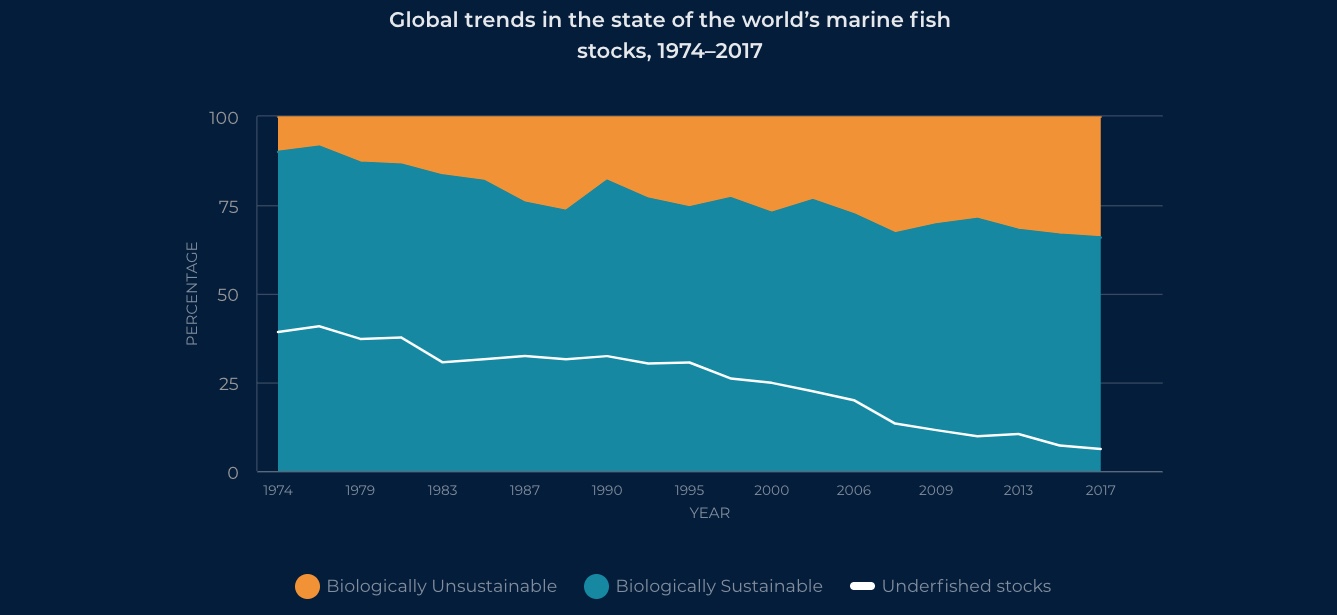Overview
AN IMPORTANT GLOBAL FOOD SOURCE
This goal assesses our ability to sustainably maximize wild-caught fisheries.
GOAL DESCRIPTION
One of the most fundamental services the ocean provides is the provision of seafood. One in 7 people rely on fish as a daily source of protein, yet global catches have been declining steadily since peak catch in 1996 (Pauly and Zeller 2016). Given pressures on fisheries and projected increases in human population, it may become difficult to rely on wild-caught marine fish to meet basic nutritional needs.
The wild-caught fisheries subgoal evaluates how well we maximize harvest without damaging the ocean’s ability to continue providing fish for people in the future. The sustainable harvest of wild-caught seafood avoids excessively high exploitation of target species and does not target threatened populations. Each year’s catch must not take so much from the population that future catches will decline. This means that an accurate assessment of the status of marine fish stocks is crucial to avoid overfishing which can threaten human food supplies and the social and economic sustainability of fishing communities worldwide.
The status of a fishery is usually measured by the current abundance of a stock(s), expressed as biomass of fish in the water, relative to a reference point. For example, the UN Food and Agriculture Organization (FAO) categorizes stocks as ‘overexploited’, ‘fully exploited’ or ‘underexploited’ depending on whether the current biomass is less than 40 percent, 40-60 percent, or greater than 60 percent, respectively, of the ‘pristine’ (unfished) biomass (Ye 2011).

(image from FAO 2020)
The Ocean Health Index uses estimates of biomass to assess stock status, with the reference point that the biomass of all stocks should be at the level that provides maximum sustainable yield.
Stock status can also be judged by spawning potential, catch trend, and size-age composition. Spawning potential is measured as the ratio of the total biomass of sexually mature fish in the stock (‘spawning stock biomass’) to the number of fish large enough to be caught that ‘recruit’ to the population each year through growth or migration. Ratios of less than 20 percent, 20-40 percent and greater than 40 percent indicate stocks that are ‘overexploited’, ‘fully exploited’ and ’non-fully exploited’, respectively. Catches that drop significantly without reduction of fishing effort or that are less than 50 percent of the maximum indicate an overexploited stock, as does an unstable size-age composition. Catches that remain at or close to peak values for the past 5-10 years and/or have stable size-age composition indicate a fully exploited stock. Catches that increase with increased effort without any change in size-age composition are non-fully exploited (Ye 2011).
LEARN MORE
Explore the full description of the data and model used in the Global OHI MODEL. Or, take a look at PRACTICAL GUIDANCE for advice on adapting the goal for future assessments and to learn how previous OHI+ assessments have modified this goal to address differences in data availability or priorities.
OTHER RESOURCES
FOOD AND AGRICULTURE ORGANIZATION OF THE UNITED NATIONS (FAO)
Fishery Fact Sheets Collections. ASFIS List of Species for Fishery Statistics Purposes.
Learn more
FISHBASE
Developed at the WorldFish Center in collaboration with the Food and Agriculture Organization of the United Nations (FAO) and many other partners, this global information system provides detailed information on almost all of the known world fish species and aquatic living organisms (marine and freshwater), and is searchable by country and species.
Learn More
THE SEA AROUND US PROJECT
The Sea Around Us project investigates the impact of fisheries on the marine ecosystems of the world, and offers mitigating solutions to a range of stakeholders. The project is a scientific collaboration between the University of British Columbia and the Pew Environment Group that began in July 1999. The Sea Around Us project conducts a catch reconstruction program, the results of which improve the accuracy of estimates of catch, stock exploitation status, and other key factors for fisheries management.
Learn More
REFERENCES
Pauly D and Zeller D (2016) Catch reconstructions reveal that global marine fisheries catches are higher than reported and declining. Nature Communications 7: 10244.
Ye, Y. (2011). Assessment methodology. Appendix, pp. 327-334 in: FAO. 2011. Review of the state of world marine fishery resources. FAO Fisheries and Aquaculture Technical Paper 569. 334 pp. Food and Agriculture Organization of the United Nations, Rome
FAO. (2020). The State of World Fisheries and Aquaculture 2020: Interactive story. https://www.fao.org/state-of-fisheries-aquaculture